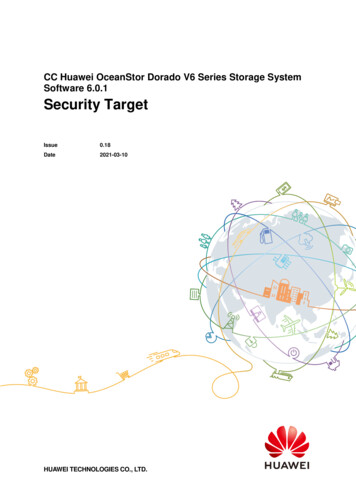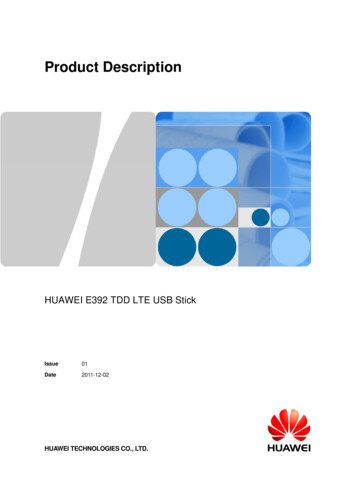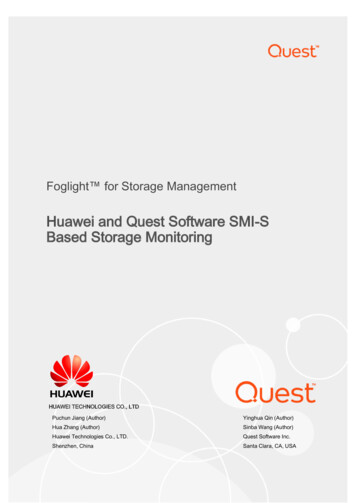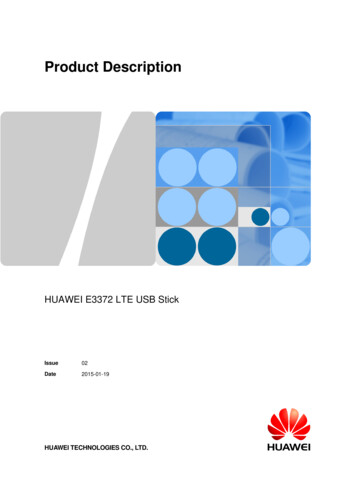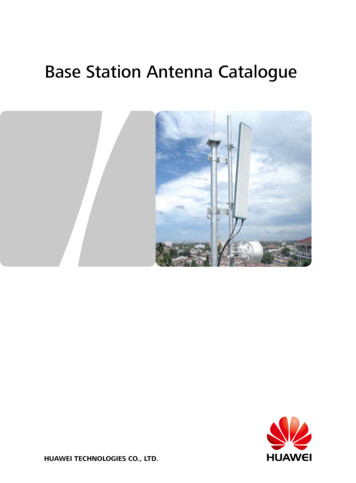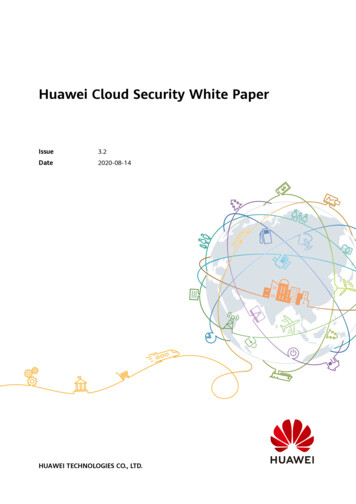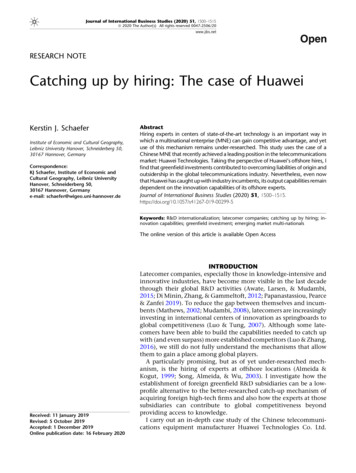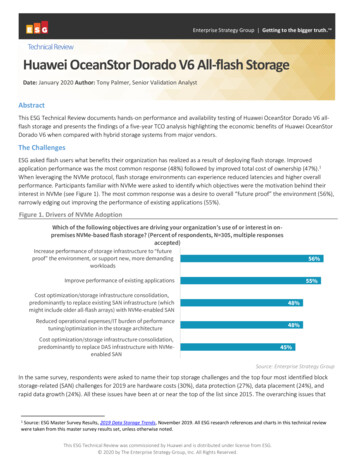
Transcription
Enterprise Strategy Group Getting to the bigger truth. Technical ReviewHuawei OceanStor Dorado V6 All-flash StorageDate: January 2020 Author: Tony Palmer, Senior Validation AnalystAbstractThis ESG Technical Review documents hands-on performance and availability testing of Huawei OceanStor Dorado V6 allflash storage and presents the findings of a five-year TCO analysis highlighting the economic benefits of Huawei OceanStorDorado V6 when compared with hybrid storage systems from major vendors.The ChallengesESG asked flash users what benefits their organization has realized as a result of deploying flash storage. Improvedapplication performance was the most common response (48%) followed by improved total cost of ownership (47%).1When leveraging the NVMe protocol, flash storage environments can experience reduced latencies and higher overallperformance. Participants familiar with NVMe were asked to identify which objectives were the motivation behind theirinterest in NVMe (see Figure 1). The most common response was a desire to overall “future proof” the environment (56%),narrowly edging out improving the performance of existing applications (55%).Figure 1. Drivers of NVMe AdoptionWhich of the following objectives are driving your organization’s use of or interest in onpremises NVMe-based flash storage? (Percent of respondents, N 305, multiple responsesaccepted)Increase performance of storage infrastructure to “futureproof” the environment, or support new, more demandingworkloads56%Improve performance of existing applications55%Cost optimization/storage infrastructure consolidation,predominantly to replace existing SAN infrastructure (whichmight include older all-flash arrays) with NVMe-enabled SAN48%Reduced operational expenses/IT burden of performancetuning/optimization in the storage architecture48%Cost optimization/storage infrastructure consolidation,predominantly to replace DAS infrastructure with NVMeenabled SAN45%Source: Enterprise Strategy GroupIn the same survey, respondents were asked to name their top storage challenges and the top four most identified blockstorage-related (SAN) challenges for 2019 are hardware costs (30%), data protection (27%), data placement (24%), andrapid data growth (24%). All these issues have been at or near the top of the list since 2015. The overarching issues that1Source: ESG Master Survey Results, 2019 Data Storage Trends, November 2019. All ESG research references and charts in this technical reviewwere taken from this master survey results set, unless otherwise noted.This ESG Technical Review was commissioned by Huawei and is distributed under license from ESG. 2020 by The Enterprise Strategy Group, Inc. All Rights Reserved.
Technical Review: Huawei OceanStor Dorado V6 All-flash Storage2drive these data storage concerns are relatively unchanged—data growth is accelerating, and the resulting infrastructurerequired to store and protect that data is costly and complex.Organizations are tasked with providing a high-quality, predictable, and productive computing environment for an evergrowing number of internal users and external customers. In addition, enterprise application environments have becomeincreasingly unpredictable as their underlying IT infrastructure grows in complexity and size. Mission-critical businessapplication performance is sensitive to storage performance and latency, and highly dependent on the resilience of the ITenvironment.The ability to consolidate critical workloads and functions onto a single all-flash storage system has proven to providesignificant TCO benefits if an organization’s performance, reliability, and operational requirements can be met. While manystorage vendors offer all-flash solutions, the design decisions and tradeoffs made by these vendors can result in verydifferent system capabilities and ultimately tradeoffs in benefits to an organization.The Solution: Huawei OceanStor Dorado V6 All-flash StorageHuawei designed the OceanStor Dorado all-flash storage to handle mission-critical applications, both internal and customerfacing, for large enterprises, as well as mixed workloads. The OceanStor Dorado leverages a multiple controller, end-to-endnon-volatile memory express (NVMe) architecture they call SmartMatrix to reduce the latency in accessing NVMe and flashbased storage and ensure high availability. It can scale out since the OceanStor Dorado V6 supports up to 32 controllers.Figure 2. Huawei OceanStor Dorado V6 All-flash StorageSource: Enterprise Strategy GroupHuawei offers many features to maximize OceanStor Dorado performance, availability, and efficiency, while minimizingoverall total cost of ownership (TCO):Performance—Huawei OceanStor Dorado all-flash storage system has an NVMe-based architecture, which supports directcommunication between the CPU and NVMe SSDs. This eliminates the need for SCSI-SAS conversion and shortens the datatransmission path, lowering end-to-end latency. SAS flash drives are supported for workloads that don’t require theextreme performance of NVMe. The system also incorporates a disk controller collaboration algorithm developed byHuawei, which synchronizes the data layout between SSDs and controllers designed to provide performance at aconsistently low latency, ensuring that mission-critical applications always operate smoothly.Availability—The Huawei SmartMatrix fully interconnected architecture tolerates failure of up to seven controllers. Huaweiemploys multiple layers of software to provide high availability in its platform. Huawei employs RAID-TP, its implementationof triple-parity RAID that allows for up to three simultaneous disk failures. 2020 by The Enterprise Strategy Group, Inc. All Rights Reserved.
Technical Review: Huawei OceanStor Dorado V6 All-flash Storage3 SmartMatrix architecture supports full interconnection between front-end interface cards, controllers, and back-enddisk enclosures; combined with the software technology of cache triple copy and continuous mirroring, hardware faulttolerance is extremely high. OceanStor Dorado Tolerates failure of seven out of eight controllers and ensuresuninterrupted business continuity. RAID-TP also enables fast rebuild of data, with hot spare space spread across all disk modules. HyperSnap snapshots provide point-in-time redirect-on-write (ROW) snapshots for fast recovery of data with minimalimpact on performance. ROW snapshots are optimized for performance, requiring one-third of the I/O operations ofcopy-on-write snapshots with no computational overhead when reading snapshots. HyperReplication provides a traditional remote replication to a standby data center, and HyperMetro employs agateway-free active/active deployment of two storage arrays that balances the load between them and permits nondisruptive cross-site takeover in case one array or one link between the array and host fails to ensure continuous dataaccess for the most critical business applications.Automated Data Infrastructure Management—Huawei OceanStor Dorado all-flash storage system provides a three-layer AIarchitecture to help organizations automate data management. DeviceManager simplifies configuration, operations, andmaintenance at the system and component level. OceanStor DJ virtualizes storage systems into a programmable storagepool, enabling automated, service-based storage to be easily provisioned and managed. The eService Intelligent Operationsand Maintenance (O&M) platform helps organizations achieve an intelligent lifecycle, from resource provisioning to faultfingerprinting, to intelligent, predictive analytics and optimization. Huawei has also introduced FlashEver, an upgradeservice that allows organizations to independently replace controllers and disk enclosures with no data migration or servicedisruption. The FlashEver service also provides free access to next-generation hardware.2Cost of Ownership—Huawei employs its implementation of smart deduplication and compression to provide significant datareduction in the OceanStor Dorado V6. Huawei provides customers a new business model they call “available capacity.”Huawei offers real-world, guaranteed storage capacity3 leveraging built-in data deduplication and compression to reducethe storage space of application data while ensuring performance. This can offer customers enhanced return on investment(ROI) with the subsequent reduction in data center footprints, power, and cooling resources. SmartThin provisioningenables organizations to provision only what they need today, growing capacity on demand, non-disruptively.ESG TestedESG performed hands-on testing and validation of the Huawei OceanStor Dorado V6 all-flash storage system at Huawei’sfacilities in Chengdu, China. Testing was designed to validate the performance, reliability, data management, and TCO of theOceanStor Dorado V6 storage platform with a focus on delivering high levels of predictable performance. The ability tosustain these performance levels through various storage hardware failures was also tested. Finally, we looked at theautomated data management capabilities of the platform and a five-year TCO analysis was performed.PerformanceThe performance test bed utilized by ESG consisted of 12 Huawei FusionServer RH Series Rack servers, each leveraging dualeight-core processors with 256 GB of RAM. The servers were connected to redundant FibreChannel Switches via 16GFC. Theswitches were then connected via two pairs of 16GFC cables to one Huawei OceanStor Dorado 18000 V6 storage systemwith one controller enclosure containing a total of four controllers and four disk enclosures, populated with a total of 411.92TB NVMe SSD modules.An Oracle RAC 18c Enterprise Edition cluster was deployed on 12 physical servers with 6.8 TB of capacity allocated across 20volumes. OLTP testing was performed using Swingbench version 2.5.0.919. SLOB version 2.4.2 was used with one instanceof Oracle 18c Enterprise Edition to run an OLTP workload, testing for latency. ESG leveraged the Huawei OceanStorDeviceManager interface (shown in Figure 3) to manage the environment and monitor the tests. Test results were verified2Contact your local Huawei supplier for more details. 2020 by The Enterprise Strategy Group, Inc. All Rights Reserved.
Technical Review: Huawei OceanStor Dorado V6 All-flash Storage4using output files and logs from the tested applications. First, ESG started an OLTP workload using SLOB. The workload wasconfigured for 75% reads and 25% updates. After the workload was running for 30 minutes, the system was servicing about220,000 sustained IOPS at an average response time of just 81 µs.Figure 3. Huawei OceanStor Dorado Performance—High IOPS, Extremely Low LatencySource: Enterprise Strategy GroupNext, we tested the Oracle RAC cluster using Swingbench. Once the warmup phase was complete and the workloadstabilized, we let the test run for 30 minutes. As seen in Figure 4, the OceanStor Dorado 18000 V6 was able to service846,091 IOPS at just 477 µs.Figure 4. Huawei OceanStor Dorado Performance—Large Scale DatabaseSource: Enterprise Strategy Group 2020 by The Enterprise Strategy Group, Inc. All Rights Reserved.
Technical Review: Huawei OceanStor Dorado V6 All-flash Storage5Next, we tested the impact of snapshots on performance. With the database workload still running, we created a protectiongroup and added all 20 volumes in the Oracle RAC cluster to it.Figure 5. Configuring HyperCDPSource: Enterprise Strategy GroupNext, we configured HyperCDP to take a snapshot every three seconds and set the retention to the maximum of 60,000snapshots. It’s important to note that 60,000 is the retention limit for a single LUN; HyperCDP can manage 2 million totalsnapshots. Snapshots can also be scheduled.Figure 6. Configuring the Snapshot ScheduleSource: Enterprise Strategy GroupThe workload ran for more than 30 minutes and HyperCDP created more than 12,000 snapshots during this time. 2020 by The Enterprise Strategy Group, Inc. All Rights Reserved.
Technical Review: Huawei OceanStor Dorado V6 All-flash Storage6As can be seen in Figure 7, performance remained steady throughout the test. The Huawei OceanStor Dorado V6 sustainedmore than 800,000 IOPS with an average response time of less than 500 µs.Figure 7. Performance with Continuous SnapshotsSource: Enterprise Strategy GroupWhy This MattersWith the number of tools and technologies that exist in a traditional enterprise environment, the cost and complexityrelated to maintaining the infrastructure, ensuring constant uptime, and guaranteeing performance levels can easily getout of hand.ESG validated that a single Huawei OceanStor Dorado V6 NVMe storage system was able to deliver higher performancewith lower latency than the previously tested OceanStor Dorado V3. As the simulated database workload ramped up onone server, response time remained extremely low. ESG confirmed that the OceanStor Dorado V6 sustained more than220,000 IOPS with an average response time of just 81 µs. When we scaled the workload up to a 12 node Oracle RACcluster, we confirmed nearly 850,000 IOPS with an average response time of 477 µs. While running this workload, wesaw no discernable impact of snapshots, even though we were creating them at the rate of three per second pervolume. This translates directly to lower upfront and ongoing costs because a given workload can potentially be servicedby a smaller OceanStor Dorado configuration.AvailabilityThe Huawei OceanStor Dorado V6 all-flash storage platform is designed to ensure high availability and sustain performancethrough both planned maintenance and unplanned outages. OceanStor Dorado V6 array can house from two to 323 controllers running in active/active mode, and Huawei’sSmartMatrix architecture can tolerate the failure of seven out of eight controllers and three out of four in a fourcontroller system. SmartMatrix architecture supports full interconnection between front-end interface cards,controllers, and back-end disk enclosures; with the software technology of cache triple copy and continuous mirroring,hardware fault tolerance is extremely high and helps to ensure uninterrupted business continuity. HyperMetro provides a gateway-free active/active high-availability solution between OceanStor Dorado V6 systems,either in the same data center or different data centers that are up to 100km apart. HyperMetro maintains dataconsistency between the storage arrays in two ways: If one array fails, HyperMetro will switch the failed array’s332 controller configurations will be available in the OceanStor Dorado 18000 V6 in 2020. 2020 by The Enterprise Strategy Group, Inc. All Rights Reserved.
Technical Review: Huawei OceanStor Dorado V6 All-flash Storage7workload to the redundant array immediately; if a link between a host and an array fails, HyperMetro will direct thehost to the array, which continues to provide data access. Huawei’s implementation of RAID-TP can tolerate up to three simultaneous disk failures. With Huawei’simplementation of RAID-TP, parity data and hot spare space is spread across all disks in the storage pool, decreasingreconstruction time and increasing overall storage availability to better ensure continuous data access.ESG tested using a single host attached to the OceanStor Dorado 18000 V6 via two 16GFC links. We began by running a testworkload using Vdbench to generate traffic against four LUNs in the system. The total workload generated by the serverwas 111,782 IOPS. Each of the four LUNS was servicing approximately 28,000 IOPS, and each controller in the array was alsoprocessing approximately 28,000 IOPS.I/O response time was under 100 µs across all four controllers. Next, we disabled one of the four LUNs.Figure 8. Performance of Huawei OceanStor Dorado 18000 V6 After LUN DisabledSource: Enterprise Strategy GroupFigure 8 shows that when the total IOPS for LUN 0001 dropped to zero, the four controllers balanced the load on theremaining three LUNs evenly. Next, we pulled three of the four controllers (Controller B, then A, then C) out of the array tosee how the system would react. Figure 9 shows the performance of the array as the controllers are removed. When westarted the test, the system was servicing about 200,000 IOPS with an average response time of 18.5 µ sec.Figure 9. Performance as Three Controllers are Removed and RestoredSource: Enterprise Strategy Group 2020 by The Enterprise Strategy Group, Inc. All Rights Reserved.
Technical Review: Huawei OceanStor Dorado V6 All-flash Storage8As we pulled each controller, the remaining controllers took up the slack and response time spiked briefly but neverexceeded 115 µsec. When controllers A, B, and C were all offline, Controller D was servicing the entire 200,000 IOPSworkload at 18 µ sec.Figure 9 also shows that as each downed controller was brought back online, traffic was evenly balanced across the activecontrollers, until the original four controllers were again sharing the load.It’s important to note that the system never stopped servicing I/O and response time averaged under 20 µ sec during thistest. This is important both when recovering from an unplanned event, and when executing planned maintenance, like asoftware update or an in-place controller upgrade. As we pulled each disk, IOPS gradually decreased and response timegradually increased as the array had to reconstitute data from parity on the fly.The array remained available throughout the triple disk failure without a significant degradation in performance. Total IOPSdecreased from a total average of approximately 100,000 to approximately 80,000 while response time increased from thepreviously observed average of 250 µs to an average of 850 µs.Finally, ESG looked at RAID-TP rebuild times. With increasing data set sizes, fast rebuild time after a disk failure orreplacement is critical. We pulled a disk from an array populated with 36 disks that hosted a 7.1TB volume. Figure 10 showsthe actions performed by the array to rebuild the data from the failed disk and the elapsed time.Figure 10. Huawei OceanStor Dorado V6 RAID-TP Fast RebuildSource: Enterprise Strategy GroupWhen the array detects the removed disk, the reconstruction process begins. As Figure 10 shows, the rebuild of the 7.1TBvolume took just six minutes to complete, 33% faster than the OceanStor Dorado V3 we tested in 2018.ESG tested HyperMetro in an on-campus setting, with two OceanStor Dorado V6s named DoradoV6 A and DoradoV6 Bconfigured as a HyperMetro pair in different areas in the same data center. We began by running an OLTP workload tosimulate transactional database traffic on an Oracle 12c Real Application Cluster (RAC). Each server was dual attached to theSAN and zoned to have access to both controllers on each array, and the two arrays were connected via dual FC links.Figure 11 shows the IOPS and response time of DoradoV6 A as the test was executed. The total workload generated by thetwo servers was approximately 7,500 IOPS. Each array was processing half of the workload, 3,750 IOPS on average. AverageI/O response time was 100 µs across all four controllers. 2020 by The Enterprise Strategy Group, Inc. All Rights Reserved.
Technical Review: Huawei OceanStor Dorado V6 All-flash Storage9Figure 11. Performance of Huawei OceanStor Dorado 18000 V6 During HyperMetro SwitchoverSource: Enterprise Strategy GroupNext, we simulated a failure of DoradoV6 B by pulling the power cord. This shows how the storage responded afterHyperMetro moved 100% of the workload onto DoradoV6 A. When DoradoV6 B lost power, there was a brief drop in I/O,and the response time peaked at 4ms, then settled back to 100 µs and I/O was being serviced by DoradoV6 A. We poweredDoradoV6 B on and watched as the system automatically recovered. All writes that had accumulated during the outagewere synced back to DoradoV6 B completely non-disruptively.Finally, we tested non-disruptive planned maintenance. Specifically, we upgraded a controller while the system wasrunning, simulating a customer’s experience with Huawei’s FlashEver upgrade service.Figure 12. Non-disruptive Controller UpgradeSource: Enterprise Strategy Group 2020 by The Enterprise Strategy Group, Inc. All Rights Reserved.
Technical Review: Huawei OceanStor Dorado V6 All-flash Storage10With the same workload running that we used in the HyperMetro test, we selected FRU replacement and opened theReplace Controller Wizard. With a couple of clicks, we took Controller B out of service and initiated the replacement. Thesystem ran through a number of checks as it brought the new controller online. The workload continued to rununinterrupted, and response time averaged 200 µs.Why This MattersCustomers considering solid-state storage deployment are looking not just for performance, but to increase dataavailability so that users have continuous data access for mission-critical business applications. If the underlying storageis not highly available, the risk of downtime and, subsequently, lost productivity and revenue become real. In today’sbusiness climate, IT professionals must ensure business continuity for data-intensive applications, from traditional CRMto real-time analytics and online transactions, to help their users respond to customer needs quickly.ESG validated that the SmartMatrix fully interconnected architecture of the OceanStor Dorado V6 is highly available andprovides extremely low-latency performance during planned and unplanned outages. We verified that the active/activecontrollers of the Huawei OceanStor Dorado V6 provide consistent, evenly balanced performance across all controllers ina system across a wide variety of situations, from failed disks to FRU replacement and firmware upgrades, to siteoutages. ESG was particularly impressed with the ability of the system to sustain high levels of performance with submillisecond response times through multiple disk failures, during fast RAID rebuilds, and after the failure of an entirearray using HyperMetro.Automated Data Management with Huawei AI ArchitectureHuawei AI architecture is designed to help organizations automate data management from configuration, operations, andmaintenance at the system and component level with DeviceManager, to storage system virtualization into aprogrammable, service-based storage pool with OceanStor DJ, to intelligent lifecycle management, from resourceprovisioning to fault fingerprinting, to intelligent, predictive analytics and optimization with the Huawei eService O&Mplatform. ESG tested the eService platform, examining the insights available to administrators. As seen in Figure 13, a healthcheck of our test system showed that while the system was at just over 63% capacity, in less than one month the systemwould be over 80% capacity, and eService made a suggestion that the system would need an additional 370 TB of capacityover the next 12 months.Figure 13. Huawei eService Operations and MaintenanceSource: Enterprise Strategy Group 2020 by The Enterprise Strategy Group, Inc. All Rights Reserved.
Technical Review: Huawei OceanStor Dorado V6 All-flash Storage11This exercise was performed at the device level, but Huawei offers the same optimized operations and maintenance acrossthe data center, and in the cloud.Total Cost of Ownership (TCO)ESG modeled and compared the storage-related costs that could be expected when deploying traditional hybrid storagewith SAS-based SSD and disk and a Huawei OceanStor Dorado 5000 V6 with NVMe SSDs. The costs associated withpurchasing, maintaining, powering, and cooling the storage systems were calculated in US Dollars, and the average cost forelectricity in the United States as reported by the US Energy Information Administration 4 was used to calculate power andcooling costs. ESG modeled the expected storage total cost of ownership (TCO) for a company that needed to support ahighly available mixed-workload production environment. All workloads were assumed to require sub-millisecond responsetimes: A 10TB Oracle RAC OLTP environment able to support 100,000 IOPS and sub-millisecond response times. A 9.6TB, 1,000-seat VDI deployment for heavy users (20 IOPS per user). A 5TB Microsoft Exchange environment to support 5,000 heavy users at one IOPS per user.The Huawei OceanStor Dorado 5000 V6 was populated with 18 1.92TB NVMe SSDs configured in a single RAID-TP group. Wecompared that with a hybrid storage system from a major vendor populated with 12 900GB 2.5” SAS SSDs and 652 900GB2.5” SAS HDDs configured in RAID5 groups. Both systems were modeled with equivalent software, power supplies, racks,and accessories according to each manufacturer’s best practices.TCO was calculated using a simplified model based on costs that would be incurred over a five-year period without takinginto consideration capacity and performance growth requirements or IT operational costs. Maintenance and supportcontracts, along with typical customer discounts for hardware, software, and maintenance were factored into the estimatedcosts. Figure 14 shows the TCO cost comparison between hybrid storage and the Huawei OceanStor Dorado 5000 V6.Figure 14. TCO Comparison between the OceanStor Dorado 5000 V6 and Hybrid Storage 800,00075% Less Power/Cooling 700,00084% Less Maintenance/Support 600,00075% Less HW SW Cost 500,000Overall 78% Lower TCOover 5 Years 400,000 300,000 200,000 100,000 -Hybrid StorageHW SWMaintenance and SupportOceanStor Dorado 5000 V6Power Consumption / CoolingSource: Enterprise Strategy Group4https://www.eia.gov/ 2020 by The Enterprise Strategy Group, Inc. All Rights Reserved.
Technical Review: Huawei OceanStor Dorado V6 All-flash Storage12Over five years, TCO for the hybrid storage system totals 697,568, while the costs for the OceanStor Dorado 5000 V6 isonly 150,836, just 21.6% of the hybrid storage total cost. Cost savings were similar across all three measured categories—hardware/software, maintenance/support, and power/cooling.It’s worth noting that given the availability and AI-driven automation features of the Huawei OceanStor Dorado V6, IToperational costs should be lower as well. Based on our research and experience, SSDs encounter fewer storage failures inthe field, which translates into less time and resources spent replacing disks.Why This MattersOrganizations understand the advantages to be gained by selecting a next-generation purpose-built all-flash arraydesigned to take advantage of the benefits of flash technology over simply adding flash drives to a traditional storagesystem with traditional limitations. While IT professionals seek high storage performance and availability, they still needto minimize both initial capital outlays and related operational costs over time. Solid-state storage has become a viableoption as SSD prices have declined while their reliability has increased. Simultaneously, the costs for operating andmaintaining a hybrid SSD HDD environment tends to get higher over time, especially as HDD reliability degrades withcontinuous use.ESG compared the five-year TCO of the OceanStor Dorado 5000 V6, populated with NVMe SSDs, against that of a hybridstorage system with a mixed SSD/HDD environment of SAS SSDs and HDDs. The results showed that the five-year TCO ofthe OceanStor Dorado V6 is 78% lower than that of the hybrid array, with savings spread evenly across capital outlay forhardware/software, maintenance/support contracts, and power and cooling. ESG also expects that the IT operationalcosts will decrease as well due to the increased reliability of SSDs and the automation and availability features thatHuawei has built into its all-flash array, allowing IT professionals to spend more time and resources on strategic activities,rather than maintaining storage. 2020 by The Enterprise Strategy Group, Inc. All Rights Reserved.
Technical Review: Huawei OceanStor Dorado V6 All-flash Storage13The Bigger TruthESG research reveals that organizations have realized numerous benefits as a result of deploying flash storage, includingimproved application performance (48%) and improved total cost of ownership (47%). In the same survey, respondentsidentified both a desire to overall “future proof” the environment (56%) and to improve the performance of existingapplications (55%) as among the objectives motivating their interest in NVMe, making them the two most-cited responses,based on the promise of reduced latencies and higher overall performance offered by the technology.Data growth is accelerating, and the resulting infrastructure required to store and protect that data is costly and complex.Organizations are tasked with providing a high-quality, predictable, and productive computing environment for an evergrowing number of internal users and external customers while enterprise application environments have becomeincreasingly unpredictable as their underlying IT infrastructure grows in complexity and size. Mission-critical businessapplication performance is sensitive to storage performance and latency and highly dependent on the resilience of the ITenvironment.The OceanStor Dorado V6 all-flash storage system is designed to handle mission-critical applications and workloads, bothinternal and customer-facing. The OceanStor Dorado V6 leverages an active/active multi-controller, NVMe architecture, andenterprise-class availability features implemented in software to provide a platform engineered for consolidating missionand business-critical workloads at extremely low latencies.ESG testing validated Dorado V6’s ability to consolidate the most challenging business- and mission-critical workloads onto asingle, high-performance, highly available platform. The environment ESG tested serviced an Oracle RAC 18c databaseenvironment with 24 TB of live data onto a single Dorado 18000 V6 system. The OceanStor Dorado V6 serviced more than220,000 IOPS at just 81 µs average response time and scaled to more than 846,000 IOPS with 477
Huawei offers real-world, guaranteed storage capacity3 leveraging built-in data deduplication and compression to reduce the storage space of application data while ensuring performance. This can offer customers enhanced return on investment (ROI) with the subsequent reduction in data center footprints, power, and cooling resources.
